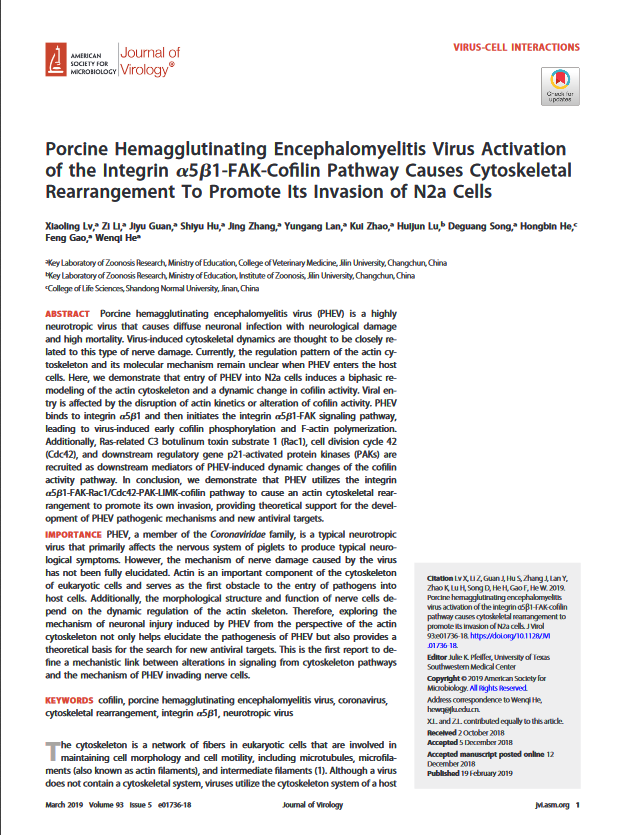05.05.2020
Porcine Hemagglutinating Encephalomyelitis Virus Activation of the Integrin α5β1-FAK-Cofilin Pathway Causes Cytoskeletal Rearrangement To Promote Its Invasion of N2a Cells
Journal of Virology, 2019
PHEV, a member of the Coronaviridae family, is a typical neurotropic virus that primarily affects the nervous system of piglets to produce typical neurological symptoms. However, the mechanism of nerve damage caused by the virus has not been fully elucidated. Actin is an important component of the cytoskeleton of eukaryotic cells and serves as the first obstacle to the entry of pathogens into host cells. Additionally, the morphological structure and function of nerve cells depend on the dynamic regulation of the actin skeleton. Therefore, exploring the mechanism of neuronal injury induced by PHEV from the perspective of the actin cytoskeleton not only helps elucidate the pathogenesis of PHEV but also provides a theoretical basis for the search for new antiviral targets. This is the first report to define a mechanistic link between alterations in signaling from cytoskeleton pathways and the mechanism of PHEV invading nerve cells.
ABSTRACT
Porcine hemagglutinating encephalomyelitis virus (PHEV) is a highly neurotropic virus that causes diffuse neuronal infection with neurological damage and high mortality. Virus-induced cytoskeletal dynamics are thought to be closely related to this type of nerve damage. Currently, the regulation pattern of the actin cytoskeleton and its molecular mechanism remain unclear when PHEV enters the host cells. Here, we demonstrate that entry of PHEV into N2a cells induces a biphasic remodeling of the actin cytoskeleton and a dynamic change in cofilin activity. Viral entry is affected by the disruption of actin kinetics or alteration of cofilin activity. PHEV binds to integrin α5β1 and then initiates the integrin α5β1-FAK signaling pathway, leading to virus-induced early cofilin phosphorylation and F-actin polymerization. Additionally, Ras-related C3 botulinum toxin substrate 1 (Rac1), cell division cycle 42 (Cdc42), and downstream regulatory gene p21-activated protein kinases (PAKs) are recruited as downstream mediators of PHEV-induced dynamic changes of the cofilin activity pathway. In conclusion, we demonstrate that PHEV utilizes the integrin α5β1-FAK-Rac1/Cdc42-PAK-LIMK-cofilin pathway to cause an actin cytoskeletal rearrangement to promote its own invasion, providing theoretical support for the development of PHEV pathogenic mechanisms and new antiviral targets.
Products featured in this study:
Acti-stain™ 535 (Cat. # CYS-PHDR1)
Cdc42 Pull-down Activation Assay Biochem Kit (bead pull-down format) - 50 Assays (Cat. # CYS-BK034)
Rac1 Pull-down Activation Assay Biochem Kit (bead pull-down format) - 50 Assays (Cat. # CYS-BK035)
Rac1 G-LISA Activation Assay (Luminescence format) - 96 assays (Cat. # CYS-BK126)
Cdc42 G-LISA Activation Assay (Colorimetric format) - 96 assays (Cat. # CYS-BK127)
Rac1 G-LISA Activation Assay Kit (Colorimetric Based) 96 assays (Cat. # CYS-BK128)
>> View article


